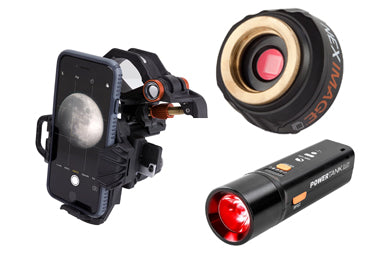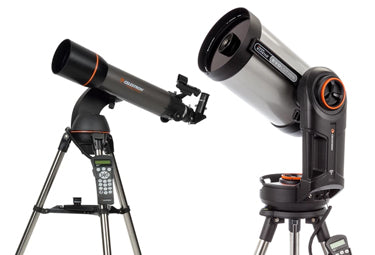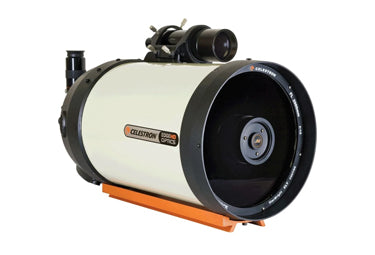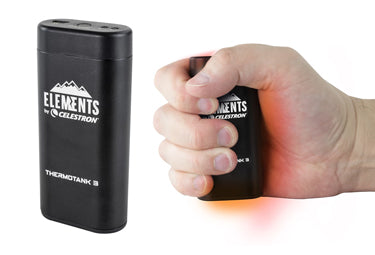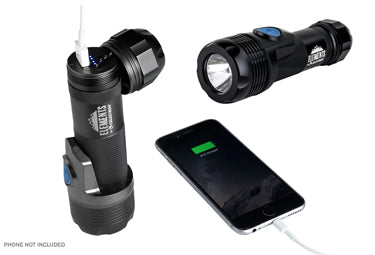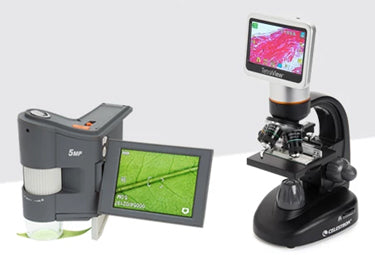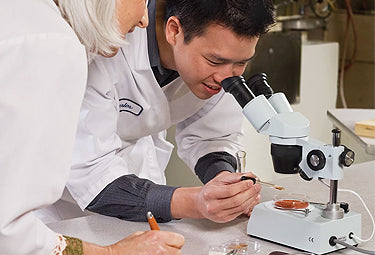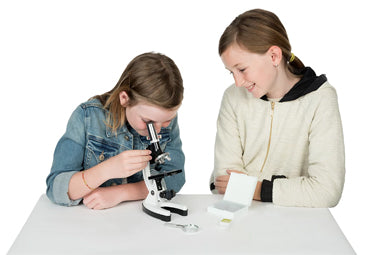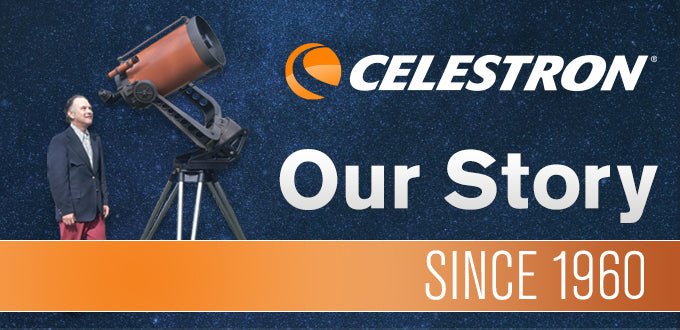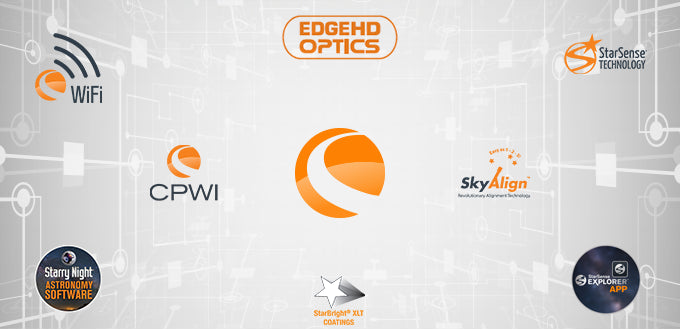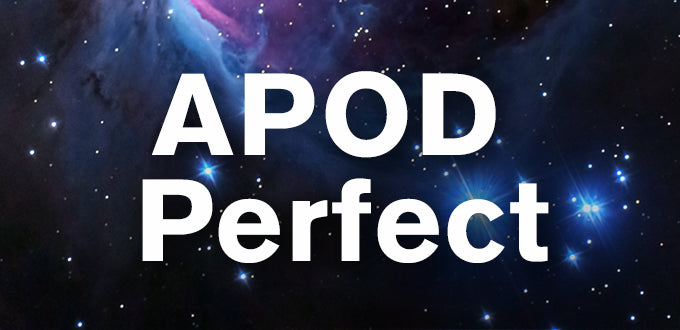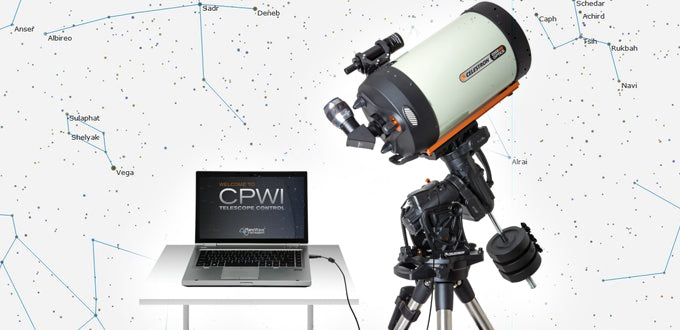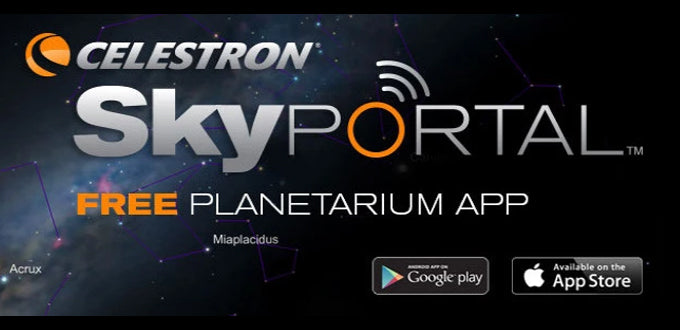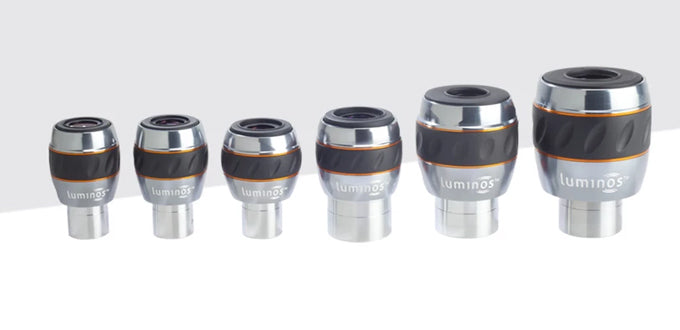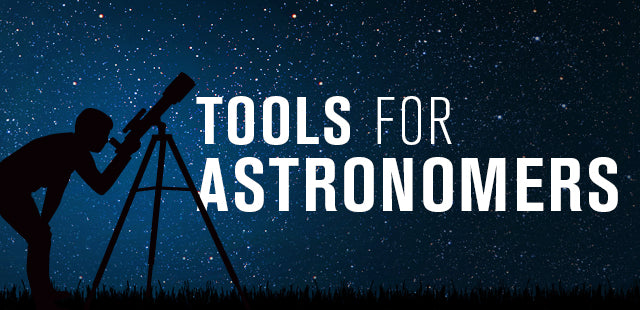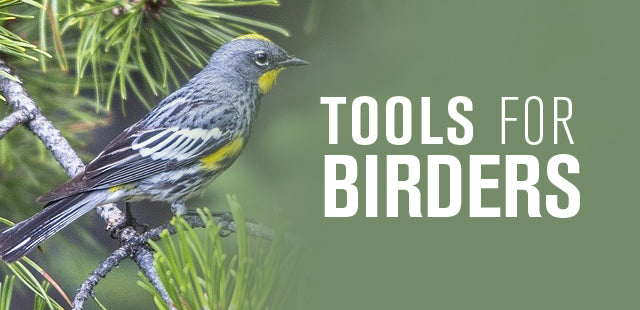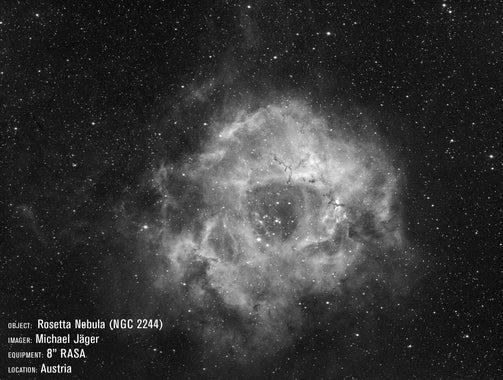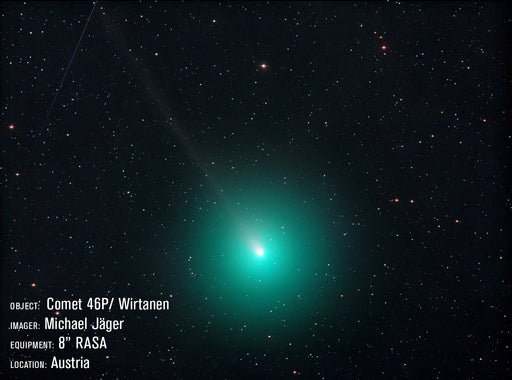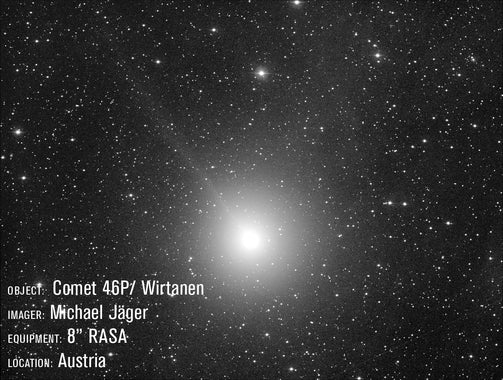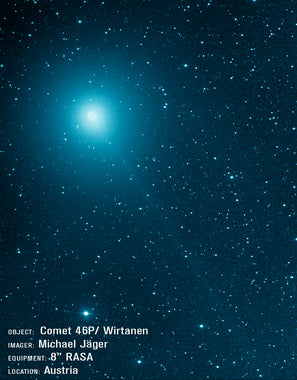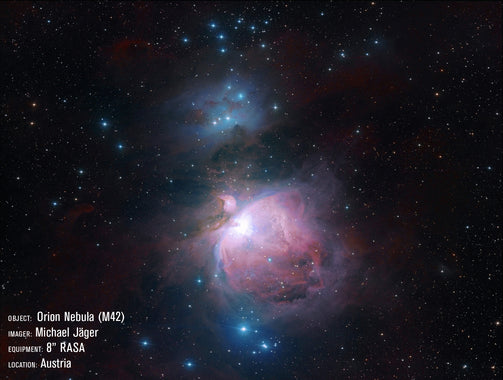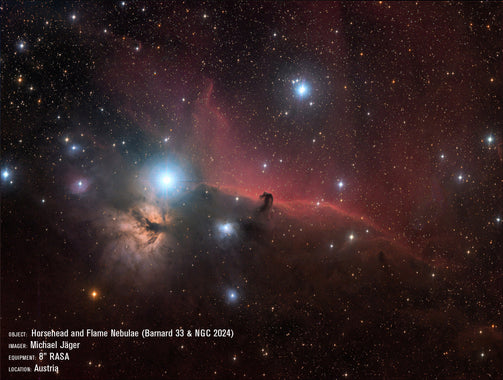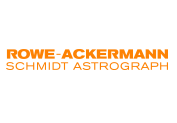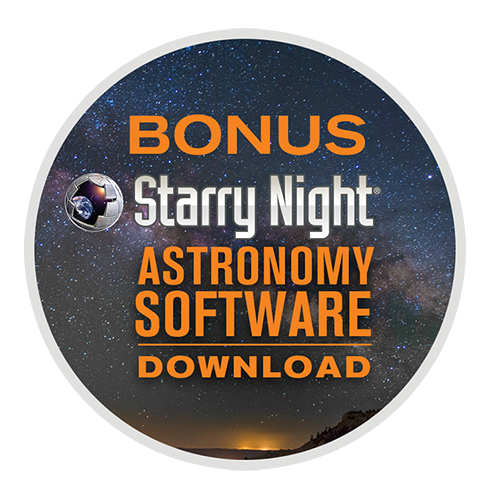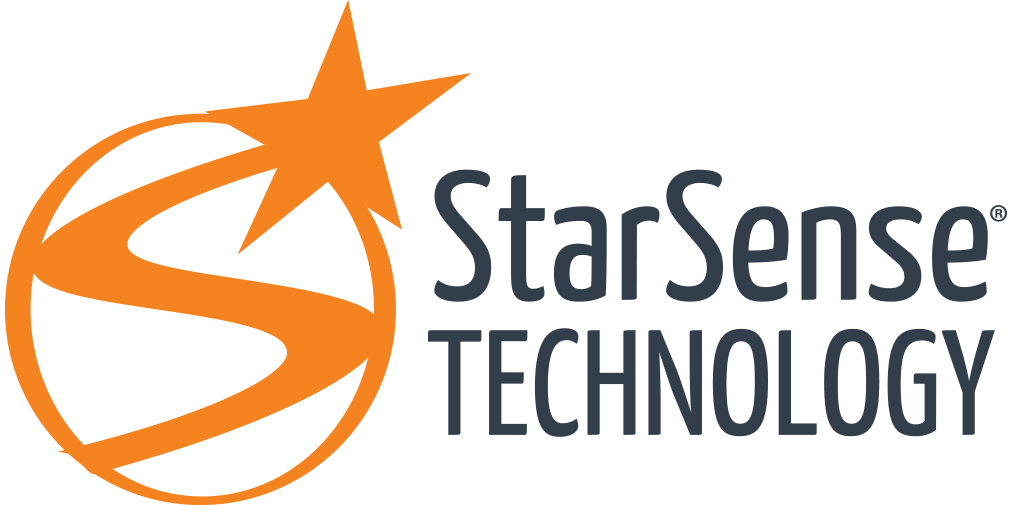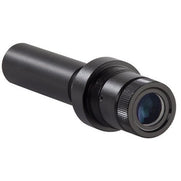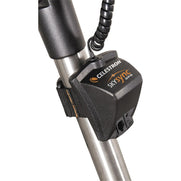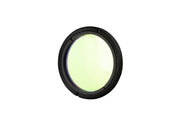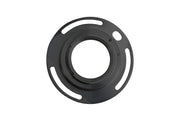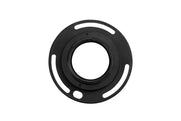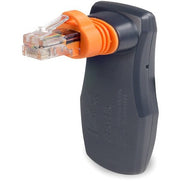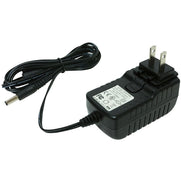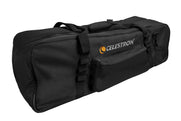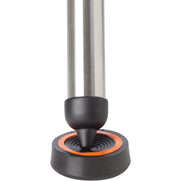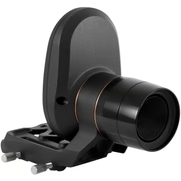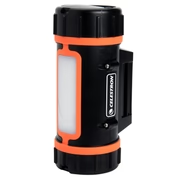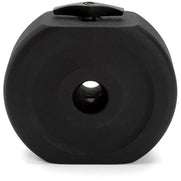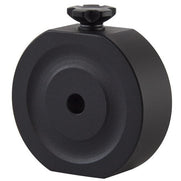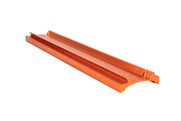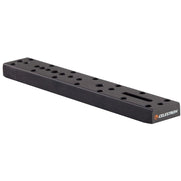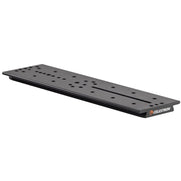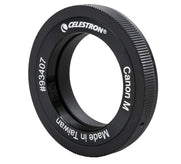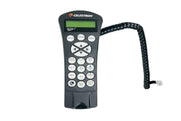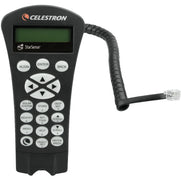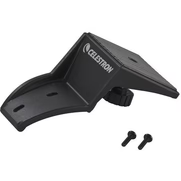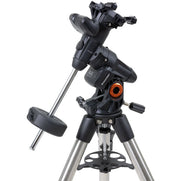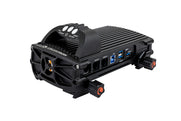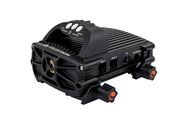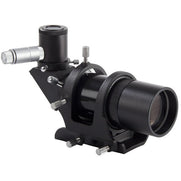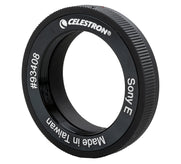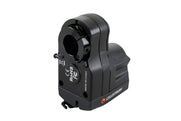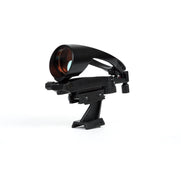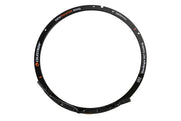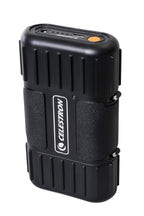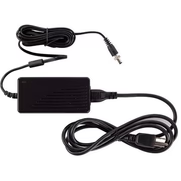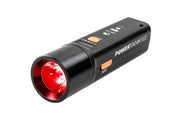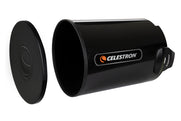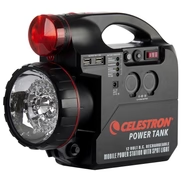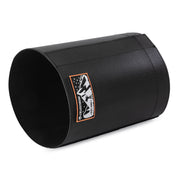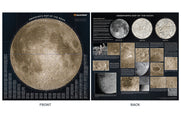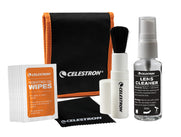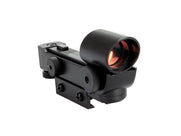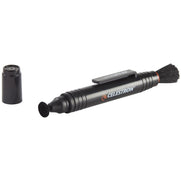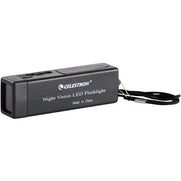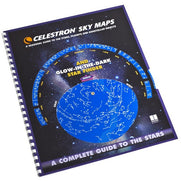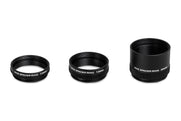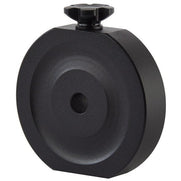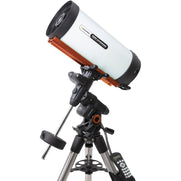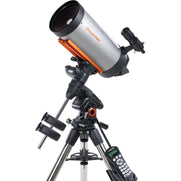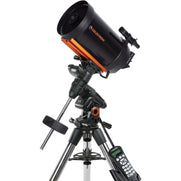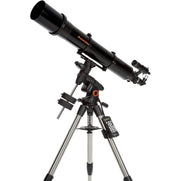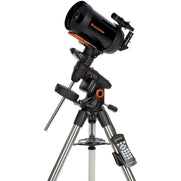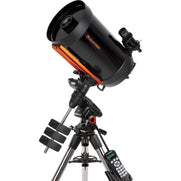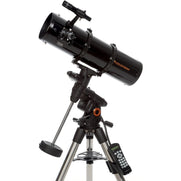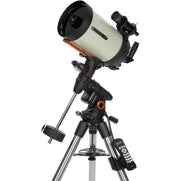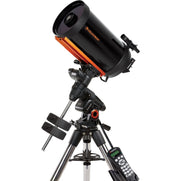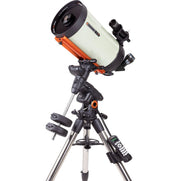Advanced VX 8" Rowe-Ackermann Schmidt Astrograph (RASA) Telescope
$2,999.00
In StockContiguous USA only
- Rowe-Ackermann Schmidt Optical Design – 8” f/2.2 flat field imaging system with rare-earth glass for outstanding images free of optical defects like field curvature, coma, astigmatism and chromatic aberration across an entire APS-C sensor.
- Unlike the larger RASAs that work with DSLR and large CCD cameras, the 8” model was designed with color astronomical CMOS cameras, smaller CCD cameras, and mirrorless cameras in mind. The astrograph does not work with standard DSLR cameras.
- Ultra-Stable Focus System – precision linear ball bearing virtually eliminates image shift.
- Integrated air-cooling system –12V DC MagLev fan reduces cooldown time and provides optimal air flow while filtering out dust.
- Internal filter mount – seamlessly accommodates a Light Pollution Imaging Filter into the optical path.
- Performs over a wider spectral range than most telescopes, from 400-800 nm, so more of the light passing through the astrograph is in sharp focus.
- Advanced VX, the most compact and portable of Celestron’s German equatorial mounts, offers a maximum instrument capacity of 30 lb with the same rigidity as our larger mounts and minimal flexure.
- This mount offers every feature an astroimager wants: PEC, an autoguider port, the ability to image across the meridian, and more.
- Dual saddle plate is compatible with narrow CG-5 dovetails and wider CGE dovetail. Also compatible with Vixen format dovetails longer than 100mm, but not compatible with Losmandy D format plates.
- Accessories included: M42 camera adapter, C-thread camera adapter, and fan battery pack.
Overview
- Rowe-Ackermann Schmidt Optical Design – 8” f/2.2 flat field imaging system with rare-earth glass for outstanding images free of optical defects like field curvature, coma, astigmatism and chromatic aberration across an entire APS-C sensor.
- Unlike the larger RASAs that work with DSLR and large CCD cameras, the 8” model was designed with color astronomical CMOS cameras, smaller CCD cameras, and mirrorless cameras in mind. The astrograph does not work with standard DSLR cameras.
- Ultra-Stable Focus System – precision linear ball bearing virtually eliminates image shift.
- Integrated air-cooling system –12V DC MagLev fan reduces cooldown time and provides optimal air flow while filtering out dust.
- Internal filter mount – seamlessly accommodates a Light Pollution Imaging Filter into the optical path.
- Performs over a wider spectral range than most telescopes, from 400-800 nm, so more of the light passing through the astrograph is in sharp focus.
- Advanced VX, the most compact and portable of Celestron’s German equatorial mounts, offers a maximum instrument capacity of 30 lb with the same rigidity as our larger mounts and minimal flexure.
- This mount offers every feature an astroimager wants: PEC, an autoguider port, the ability to image across the meridian, and more.
- Dual saddle plate is compatible with narrow CG-5 dovetails and wider CGE dovetail. Also compatible with Vixen format dovetails longer than 100mm, but not compatible with Losmandy D format plates.
- Accessories included: M42 camera adapter, C-thread camera adapter, and fan battery pack.
Description
This kit combines the 8” Rowe-Ackermann Schmidt Astrograph (RASA) with the strong-yet-portable Advanced VX (AVX) German equatorial mount. Simply add a mirrorless camera and this package offers everything you need to take spectacular images of wide-field deep sky objects.
RASA Performance Made for Everyone
Capture spectacular wide-field deep sky images in seconds with Celestron’s portable astrograph, the 8” Rowe-Ackermann Schmidt Astrograph (RASA). This incredibly fast f/2.0 system is the perfect companion to today’s color astronomical CMOS cameras, smaller CCD cameras, and mirrorless cameras. Thanks to its fast focal ratio and patented optical design, you can produce sharp, detailed images and, in many cases, skip the autoguider completely. Weighing in at just 17 pounds, it’s easy to transport your 8” RASA to the most remote dark sky locations.
RASA Performance Made for Everyone
The 8” RASA is an imaging telescope that delivers a flat field without optical aberrations for razor sharp stars across a wide field of view. It can capture stunning deep-sky astronomical images without the challenges typically presented by longer focal length instruments at a fraction of the cost of those systems.
The latest addition to the RASA family, this 8” version is a much more portable and affordable version of the heralded RASA 11, which was introduced to much acclaim in 2014. With the 8” RASA joining the lineup, a wider range of astroimagers can enjoy the benefits of the RASA design. It has many of the same thoughtfully designed features as its “big brother” RASA 11, including the integrated air-cooling system, internal filter mount, and sturdy CGE dovetail mounting bar.
Purely designed for imaging, the 8” RASA cannot be used visually. The prime focus focal plane is located at the front of the optical system, so it cannot accommodate a traditional eyepiece.
Shorter Exposure Times and Virtual “Real-Time” Observing
Since it is an F/2.0 optical system, imagers can use shorter exposure times to capture detail in faint objects. When combined with sensitive cameras and the proper “live stacking” software, the 8” RASA can provide an almost real-time observing experience. View images on a computer instantly that are brighter and more detailed than can be seen in much bigger telescopes with the naked eye.
Because shorter exposure times are possible, your equatorial mount won’t need to accurately track over extended periods. The 8” RASA’s relatively short 400mm focal length also lessens equatorial tracking demands. In many cases, autoguiding will not be required. Weighing only 17 lb, this optical tube pairs perfectly with a wide variety of mounts.
Ultra-Stable Focus System
With the launch of the 8” RASA, Celestron unveiled a new focuser design that mitigates lateral movement of the primary mirror when focusing, slewing, or tracking with the astrograph. Focusing is easier, more accurate, and more stable than ever. The key to the Ultra-Stable Focus System is a precision linear ball bearing, which is tested during assembly to ensure optimal results.
Built for Today’s Latest Cameras
Unlike the larger RASAs that work with DSLR and large CCD cameras, the 8” model was designed with color astronomical CMOS cameras, smaller CCD cameras, and mirrorless cameras in mind. The telescope does not work with standard DSLR cameras. It is optimized for sensors with up to a 22mm diagonal, but performs well with sensors up to 32mm diagonal. The APS-C sized sensors used in many mirrorless cameras are a good choice. 42mm full frame sensors will also work, but performance will be poor at the edges of the sensor and field illumination will be reduced. Additionally, we do not recommend pairing RASA 8 with any camera body more than 4” in diameter. See the chart below to determine if your camera is compatible with RASA 8.
| Camera | Compatible with RASA 8? | Adapter required |
|---|---|---|
| Astronomical CMOS/CCD camera with C-mount | Yes | C-mount adapter (included) |
| Astronomical CMOS/CCD camera with M42-thread mount | Yes | M42 adapter (included) with M42 extension tubes (not included) |
| Astronomical CMOS/CCD camera with other mount | Yes | Custom camera adapter |
| Canon mirrorless with APS-C sensor | Yes |
(sold separately) |
| Sony mirrorless with APS-C sensor | Yes |
(sold separately) |
| Canon mirrorless with full frame (42mm) sensor | Yes, but not optimized across the full sensor |
(sold separately) |
| Sony mirrorless with full frame (42mm) sensor | Yes, but not optimized across the full sensor |
(sold separately) |
| DSLR | No | -- |
Unique Optical Design
RASA’s optical design is patented (US 2016/0299331 A1). The design consists of a Schmidt corrector, primary mirror, lens group, and optical window. The lens group contains 4 elements and utilizes rare-earth elements. Unlike many telescopes that only perform well over the visible spectrum (400-700nm), the 8” RASA’s optics are designed to perform over a wider spectral range, from 400-800nm. This allows more of the light emitted from the astronomical object to be sharply focused in the image.
With many imaging systems, adding an extra piece of flat glass such as a filter does not change optical performance. However, that is not the case with super-fast optical systems like the RASA. Our engineers addressed this by designing the RASA with a removeable optical window, so you can maintain peak optical performance if a filter is added or if a camera has its own optical window. Celestron offers a Light Pollution Imaging Filter designed specifically for the 8” RASA, which mounts in place of the optical window.
All refractive optical surfaces are coated with StarBright XLT coatings, while the primary mirror uses enhanced aluminum coatings. This maintains high light transmission through the entire optical system.
When compared with “Hyperstar SCT” systems, the RASA 8 provides better optical performance and field illumination.
Advanced VX & Tripod
The Advanced VX mount is designed to provide superior performance for smaller telescopes while taking advantage of Celestron’s most advanced technologies: All-Star Polar Alignment, Celestron PWI telescope control software, and permanently programmable periodic error correction (PPEC).
If you’re an experienced imager, you’ll love taking this portable mount to a dark sky site and enjoying all the conveniences of a larger observatory mount. Or, if you’re new to imaging, Advanced VX will help you get started with the hobby and keep up with your needs for years to come.
Computerized German equatorial mount
The Advanced VX is the smallest of Celestron’s German equatorial mounts. The computerized GoTo capability automatically tracks objects as they move across the night sky. The Advanced VX mount includes ports for a hand control, an autoguider, and 2 AUX ports for optional accessories. The NexStar+ hand control gives you instant access to all the functions your mount has to offer. With automatic slewing and menu descriptions, astronomers of all skill levels can master this mount in just a few observing sessions. The Advanced VX also has an impressive tripod for its class with 2”-diameter steel tripod legs, providing an extra-wide stance for improved stability.
Payload capacity
The payload capacity for the Advanced VX is 30 lb. It offers a sturdy platform for the 8” Rowe-Ackermann Schmidt Astrograph optical tube, even when paired with optional accessories like StarSense AutoAlign, Focus Motor, a finderscope, and a camera. Celestron's payload capacity does not include the weight of the counterweights.
Dual saddle plate
As of early 2019, Advanced VX mounts include a dual saddle plate that accommodates both CG-5 and CGE-style dovetails. Switching between the two saddle plates is as simple as moving the hand knobs into a separate set of holes. You can use your Advanced VX mount not only with the 8” RASA, but virtually any optical tube within Advanced VX’s weight limit. Compatible with Vixen format dovetails 100mm or longer, not compatible with Losmandy D format plates (regardless of plate manufacturer).
Software
Celestron PWI Telescope Control Software
Your Ultimate Astronomy Software Suite
All current Celestron computerized telescopes include Celestron PWI (CPWI), the most advanced astronomy software suite provided with any consumer-grade telescope. Celestron’s experts co-developed CPWI with the engineers at PlaneWave Instruments. The result is an all-in-one solution offering you many of the same features used on PlaneWave’s observatory-class telescopes.
- Graphical planetarium interface with PointXP advanced mount modelling allows you to add 100+ points to your alignment model for the most accurate pointing and tracking possible
- Ideal for remote observatory setups: save and re-load your alignment and park your scope
- Provides a complete ASCOM telescope interface to allow control of the telescope from third party software applications
For more information on CPWI and to see the user interface, click here.
Starry Night Software
Also included with your purchase is a free download of Celestron’s Starry Night Special Edition Software. This advanced software by Simulation Curriculum offers detailed information about celestial objects and helps you plan your next observing or imaging session. The Special Edition software also includes telescope control via your PC.
Accessories Included
The Advanced VX RASA 8 comes complete with a M42 camera adapter, C-thread camera adapter, and fan battery pack.
Specifications
| Optical Tube Info: | |
|---|---|
| Optical Design: | Rowe-Ackermann Schmidt Astrograph |
| Aperture: | 203mm (8") |
| Focal Length: | 400mm (15.74") |
| Focal Ratio: | f/2.0 |
| Central obstruction diameter: | 93mm (3.66") (46% of aperture diameter) |
| Light Gathering Power (Compared to human eye): | 843x |
| Resolution (Rayleigh): | 0.68 arc seconds |
| Resolution (Dawes): | 0.57 arc seconds |
| Image Circle: | 22mm (.86") Ø, 3.15° |
| Useable field: | 32mm (1.26") Ø, 4.6°, only minimal performance loss at edge of FOV |
| Wavelength range: | 400 - 800 nm |
| Spot size: | < 4.6 μm RMS across image circle |
| Optical Coatings: | StarBright XLT |
| Off-axis Illumination: | 93% at 11mm (.43") off-axis |
| Optical Window: | 46mm (1.81") Ø |
| Back focus with included camera adapter: | 25mm (.98") |
| Back focus from top of threaded collar: | 29mm (1.14") |
| Optical Tube: | Aluminum |
| Optical Tube Length: | 628mm (24.7") |
| Optical Tube Diameter: | 235mm (9.3") |
| Focuser: | Ultra-Stable Focusing System |
| Finderscope: | Not included |
| Optical Tube Weight: | 17 lbs (7.7 kg) |
| Other Features: | Air-cooling system, integrated filter mount |
| Included Items: |
Advanced VX Equatorial Head and tripod Accessory Tray 1 x 12 lbs counterweight NexStar+ Hand Control DC Power Cable (plugs into cigarette lighter socket) |
| Dovetail: | CGE Dovetail Bar |
| Mount Info: | |
| Mount Type: | Computerized Equatorial |
| Instrument load capacity: | 30 lbs (13.6 kg) |
| Height adjustment range (includes mount and tripod): | 1118mm - 1626mm (44" – 64") |
| Tripod Leg Diameter: | 50.8mm (2") Stainless Steel |
| Latitude adjustment range: | 7° - 77° |
| Mount Head Weight: | 17 lbs (7.71 kg) |
| Accessory Tray: | Yes |
| Tripod Weight: | 18 lbs (8.16 kg) |
| Weight of Counterweights: | 1 x 12 lbs |
| Slew Speeds: | 9 slew speeds - max speed 4°/second |
| Tracking Rates: | Sidereal, Solar and Lunar |
| Tracking Modes: | EQ North and EQ South |
| GPS: | N/A |
| Dovetail Compatibility: | Dual saddle plates (CG-5 and CGE saddle) |
| Number of Auxiliary Ports: | 3 AUX Ports (1 hand control and 2 AUX Ports for optional accessories) |
| Autoguide Port: | Yes |
| USB Port: | Yes, input on Hand Control |
| Power Requirements: | 12V DC 3.5A (tip positive) |
| Motor Drive: | DC servo motors |
| Alignment Procedures: | 2-Star Align, 1-Star Align, Solar System Align, Last Alignment, Quick Align |
| Periodic Error Correction: | Yes |
| Computerized Hand Control: | NexStar+ hand control with LCD display, 19 fiber-optic backlit LED buttons |
| NexStar+ Database: | 40,000+ objects, 100 user defined programmable objects. Enhanced information on over 200 objects |
| Software: | Celestron Starry Night Special Edition Software and SkyPortal App |
| Total Kit Weight: | 47 lbs (21.31 kg) |
| Solar Warning |
|
| California Residents | View Proposition 65 Warning WARNING: Cancer and Reproductive Harm - www.P65Warnings.ca.gov. |
Videos
Reviews
Sky & Telescope’s Hot Products 2019 Award
"Incredibly fast optical speeds allow deep-sky imaging with short exposures, opening up a new world of scientific- and recreational-astrophotography possibilities."
Read Full ReviewFAQ
Why can’t the Rowe-Ackermann Schmidt Astrograph (RASA) 8 be used visually?
The optics produce an image at the front end of the telescope, not the back. Therefore, you cannot look through the RASA 8 with your eyes because your head will block the light from entering the telescope. The RASA 8 is an astrograph designed specifically for deep-sky astronomical imaging.
Why was the RASA 8 designed to have a camera mount at the front of the telescope?
The RASA 8 optical design uses a prime focus focal plane position in order to obtain its super-fast F/2.0 focal ratio. This necessitates the camera having to be mounted at the front of the astrograph.
Won’t the camera block the incoming light?
The RASA 8 optical design has its own central obstruction which is caused by the sub-aperture lens assembly at the front of the telescope. The lens assembly has an outer diameter of 93mm. If a camera’s body is smaller than this, it will not block any light from reaching the camera sensor. If the camera body is larger than this, then it will block some of the incoming light. As long as the camera body does not greatly exceed about 120mm diameter, the effect on images is negligible.
What cameras can be used with the RASA 8?
The RASA 8 can be used with many astronomical CMOS and CCD cameras. It also works well with mirrorless digital cameras. Two key considerations are the size of the camera body (should not exceed about 120mm in diameter), and the camera’s backfocus distance (cannot exceed 25mm). Color or monochrome sensors can be used, although color sensors are easiest to use since the RASA 8 cannot accommodate a filter wheel (see question #7).
Why can’t a DSLR be used with the RASA 8?
The body size of a DSLR is too large compared to the front aperture of the RASA 8, and therefore blocks too much of the incoming light. Also, the DSLR requires too much backfocus (55mm) for the RASA 8, so the camera sensor cannot be placed at the required location relative to the astrograph. For DSLR imaging, we recommend the RASA 11.
What about camera cables in front of the optics?
Camera cables which cross the front of the RASA 8 do not block much light and, don’t have a significant effect on images. To minimize any potential diffraction spike around the brightest stars, camera cables can be positioned to cross the aperture in a curved pattern, rather than a straight line.
Will I need additional camera adapters for my camera?
It depends on what camera you are using. For cameras with a C-mount, no additional adapters are required. For cameras which mount with a 42mm thread, a 42mm (or T-thread) spacer ring to place the camera sensor at the proper backfocus distance relative to the optics will be needed. (Note: With the included 42mm camera adapter, the backfocus distance required is 25mm. So, subtract the backfocus distance specification for your camera from 25mm, and that is the length of the M42 spacer ring you will need. If the camera has a backfocus distance of more than 25mm, it cannot be used with the RASA 8.) For Sony and Canon mirrorless cameras, Celestron offers optional camera adapters. For other cameras, a custom camera adapter will be needed.
What is the difference between the image circle and the useable field?
The image circle is the diameter at the focal plane (i.e. where the camera sensor is positioned) which the astrograph’s performance was optimized for. The useable field is the diameter at the focal plane where the performance of the astrograph is excellent. Most astrographs only mention the useable field in their specifications.
What if my camera’s sensor is larger than the useable field?
The RASA 8 has a useable field of 32mm. A sensor with a diagonal size larger than that, such as a full-frame mirrorless camera, can be used, but there will be some drop off in optical performance and field illumination in the corners of the image. This may require cropping during image processing.
Can filters be used with the RASA 8?
The RASA 8 has a removeable optical window which can be replaced with a filter. Currently, Celestron offers a Light Pollution Reduction Filter for the RASA 8. Filter “sliders” offered by some manufacturers may also work with some cameras. A filter wheel cannot be used, since the filter wheel would have to mount in front of the optics and would block too much of the incoming light.
Why does the RASA 8 have a removeable optical window?
With such a fast optical system, you cannot add a filter into the light path without adversely affecting the optical performance. With a removeable optical window, you can replace the window with a filter with no loss of performance.
Why is the fast focal ratio (F/2.0) of the RASA 8 such a big deal?
Because it allows much shorter exposures to be used to capture detail in fainter astronomical objects. This makes getting good images much easier and quicker. With a sensitive high-speed camera along with live image stacking software, you can see images in “real-time” on your computer screen.
What mounts can be used with the RASA 8?
Any mount which can accept a CGE (or Losmandy D) dovetail bar and can handle at least 20 lbs. The RASA 8 weighs 17 lbs, and you’ll also need to account for the weight of your camera and any other accessories.
Will I need to collimate (i.e. align) the optics?
The optics are aligned at the factory, and should not normally need adjustment. However, there are screws which adjust the tilt of the lens assembly should collimation adjustment ever be needed.
What is focus shift, and how does the Ultra-Stable Focus System (USFS) help to minimize it?
Focus shift is when the image in your camera moves a little bit when focusing. This can make critical focusing more challenging. The RASA 8 focuses by moving the primary mirror inward-and-outward. If the mirror moves at all laterally, then focus shift will result. The USFS works using a precision linear ball bearing on the shaft that supports the primary mirror. This constrains any lateral motion of the primary mirror and minimizes focus shift. This also helps prevent any unwanted lateral motion of the primary mirror (also known as “mirror flop”) as the astrograph is pointed to different positions in the night sky.
What is the extended spectral range (400-800 nm) and what is the benefit?
Most telescopes are designed to perform well over the visual spectrum (i.e 400-700nm). The RASA 8 optics were designed to perform over a wider spectral range, from 400-800nm. This means that light from 700nm-800nm will be well focused in the RASA 8, allowing more of the light emitted from the astronomical object to be sharply focused in the image. For cameras which have spectral response in the 700-800nm range, you’ll get brighter and sharper images and won’t necessarily need to use an IR-cut filter.
What else might be needed with the RASA 8?
A finderscope can be useful for visually finding objects or for initial alignment of your computerized mount with the night sky. The RASA 8 has mounting holes for a finderscope. If doing longer exposures, you may want to consider using a guide scope and autoguider in order to provide the best tracking performance with your mount. For convenient mounting of a guide scope, Celestron offers a CGE dovetail accessory mounting bar which connects to the top of the RASA 8 and allows easy installation of guide scope rings. Perhaps the most useful accessory is a focus motor, this permits focusing from the computer which is controlling the camera and/or mount. A focus motor which is compatible with the RASA 8 will soon be introduced by Celestron.
What is the purpose of the integrated air-cooling system?
The RASA 8 will perform the best when its optics have reached thermal equilibrium with the outside air. The cooling system uses a fan and vents to pull air through the astrograph and around the primary mirror in order to help the RASA 8 reach thermal equilibrium more quickly.
What is the difference between RASA 8 and an 8” SCT or EdgeHD using the Starizona Hyperstar accessory?
The RASA 8 provides better optical performance and better field illumination than an 8" SCT or Edge HD with a Hyperstar accessory. The Hyperstar accessory provides great flexibility for an SCT or EdgeHD optical system, as it allows the telescope to be used at two different focal lengths. When imaging at F/2.0 however, it cannot provide the performance of the RASA 8.
What about dew?
Just like any telescope design which uses a lens at the front of the telescope, the RASA 8 Schmidt corrector lens can be susceptible to dew under certain environmental conditions. To prevent dew when the outside temperature drops below the dew point, we recommend using a dew shield or dew heater.
I have an optical tube equipped with a Losmandy D dovetail mounting plate. Will this work with the improved Advanced VX (AVX) mount?
No, the Losmandy D dovetail plate will not fit the improved AVX mount. The improvement to the AVX mount allows it to be used with CGE format dovetail plates, but not Losmandy D format plates. The CGE and Losmandy D formats are similar, but not exactly the same. Losmandy plates are a millimeter or so wider, but CGE plates allow more surface area contact with the dovetail clamp.

What prevents the Losmandy D plates from working with the improved AVX?
The improved AVX can accept a dovetail with a maximum width of 74.5mm. The Losmandy D plate is a bit wider than that. Also, the improved AVX requires the height of the dovetail undercut to be at least 10.2mm, and the Losmandy D has a dovetail undercut which shorter than that.
So, how do I mount my optical tube with a Losmandy D dovetail plate onto the improved AVX?
You’ll need to replace the Losmandy D dovetail plate with a compatible dovetail plate, such as the Celestron #94214 CGE Universal Mounting Plate.
I have a Losmandy D format dovetail plate, but it is not manufactured by Losmandy. Will it work with the improved AVX?
No, if the dovetail plate uses the Losmandy D format, then it is not compatible with the improved AVX, regardless of the manufacturer of the plate.
I have an optical tube equipped with a Vixen dovetail mounting plate. Will this work with the improved AVX mount?
Yes, the improved AVX, like the original AVX, is compatible with Vixen format dovetail plates. However, the plate must have a dovetail length of 100mm or greater.
Why does my Vixen dovetail, or CG-5 dovetail, need to have a dovetail length of at least 100mm?
The knobs on the AVX that hold the dovetail plate in place are spaced 90mm apart. If the dovetail length is less than 100mm, then both knobs cannot come into contact the dovetail simultaneously. See the below engineering drawing.
My optical tube has a Vixen or CG-5 dovetail plate with a dovetail length of less than 100mm. How do I mount it onto the AVX?
You’ll need to replace the dovetail plate with a compatible dovetail plate, such as the Celestron #94213 Universal Mounting Plate, CG-5.
What is the heaviest recommend load for mounting a camera onto the RASA 8?
We recommend a load of no more than 20 lbs. at 4.5 inches away from the 8" Schmidt corrector.
Why is there a black ring around the edge of the primary mirror in my RASA 8 V2??
The very edge of the primary mirror is opaque black to ensure best image quality. The optical quality at the very edge of any primary mirror is generally not quite as good as the rest of the surface due to manufacturing processes. This “edge blackening” eliminates this region of the mirror, and is not uncommon for larger primary mirrors, especially those with a fast focal ratio. The RASA 8 optical design is affected by this more than other Celestron models due to its very fast focal ratio (F/2.0), hence the decision to incorporate edge blackening for this model only.
Support & Downloads
Reviews
There are currently no customer reviews.

